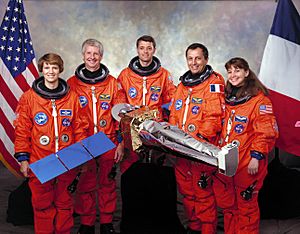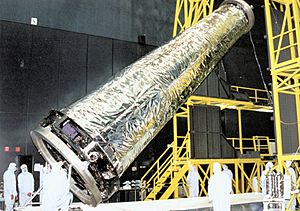Chandra X-ray Observatory facts for kids
The Chandra X-ray Observatory (CXO) is a special space telescope launched by NASA on July 23, 1999. It was previously known as the Advanced X-ray Astrophysics Facility (AXAF). Chandra is incredibly sensitive, able to see X-ray sources 100 times fainter than any X-ray telescope before it. This is thanks to its very precise mirrors.
Since Earth's atmosphere blocks most X-rays, we cannot detect them from telescopes on the ground. That's why space telescopes like Chandra are so important! Chandra orbits Earth for 64 hours at a time, and its mission is still ongoing. It is one of NASA's four "Great Observatories," alongside the Hubble Space Telescope, the Compton Gamma Ray Observatory, and the Spitzer Space Telescope. The telescope is named after the famous astrophysicist Subrahmanyan Chandrasekhar.
Contents
Chandra's Journey to Space

The idea for the Chandra X-ray Observatory, then called AXAF, was first suggested to NASA in 1976. Scientists Riccardo Giacconi and Harvey Tananbaum proposed it. Work began the next year. In 1978, NASA launched its first X-ray telescope, called Einstein, into orbit.
Throughout the 1980s and 1990s, work continued on the AXAF project. In 1992, the spacecraft was redesigned to save money. They removed four of the twelve planned mirrors and two of the six science instruments. AXAF's orbit was also changed to an elliptical one. This new orbit would take it about one-third of the way to the Moon at its farthest point. This meant the space shuttle could not visit it for repairs. However, it placed the observatory above Earth's radiation belts for most of its orbit, which is better for observations. The company TRW Inc. (now Northrop Grumman) built and tested AXAF.
How Chandra Got Its Name
In 1998, NASA held a contest to rename AXAF. More than 6,000 people from all over the world sent in their ideas. The winners, Jatila van der Veen and Tyrel Johnson, suggested the name Chandra. They chose this name to honor Indian-American astrophysicist Subrahmanyan Chandrasekhar. He won a Nobel Prize for his work on white dwarf stars. His research helped us understand high-energy space events like neutron stars and black holes.
Launch and Operations
Chandra was supposed to launch in December 1998, but it was delayed for several months. It finally launched in July 1999 aboard the Space Shuttle Columbia during mission STS-93. Weighing about 22,753 kilograms (50,162 pounds), it was the heaviest payload ever launched by the shuttle. This was because it needed a powerful two-stage rocket booster to reach its high orbit.
Chandra has been sending back amazing data since August 1999. The Smithsonian Astrophysical Observatory (SAO) operates it from the Chandra X-ray Center in Cambridge, Massachusetts. MIT and Northrop Grumman Space Technology also help.
Chandra was originally expected to last for 5 years. But on September 4, 2001, NASA extended its mission to 10 years because of its incredible discoveries. Studies show that Chandra could keep working for at least 15 years or even longer!
Amazing Discoveries by Chandra
The information gathered by Chandra has greatly improved our understanding of X-ray astronomy. Here are some of the cool things Chandra has helped us discover:
- Chandra's first image was of the supernova remnant Cassiopeia A. It showed astronomers a compact object at its center, likely a neutron star or black hole.
- In the Crab Nebula, another supernova remnant, Chandra revealed a never-before-seen ring around the central pulsar. It also showed jets that earlier telescopes had only partly seen.
- Chandra was the first to see X-ray light coming from Sagittarius A*, the supermassive black hole at the very center of our Milky Way galaxy.
- It found much more cool gas than expected spiraling into the center of the Andromeda Galaxy.
- For the first time, detailed pressure fronts were seen in Abell 2142. This is where clusters of galaxies are crashing into each other.
- Chandra took the earliest X-ray images of the shock wave from a supernova called SN 1987A.
- It showed the shadow of a small galaxy being eaten by a larger one in an image of Perseus A.
- A new type of black hole was found in galaxy M82. These "mid-mass" black holes might be the missing link between small stellar-sized black holes and huge super massive black holes.
- X-ray emission lines were linked for the first time to a gamma-ray burst called GRB 991216.
- High school students, using Chandra data, discovered a neutron star in a supernova remnant called IC 443.
- Chandra data suggested that RX J1856.5-3754 and 3C58, once thought to be pulsars, might be even denser objects called quark stars. Scientists are still discussing these findings.
- In 2003, Chandra observed sound waves from violent activity around a super massive black hole in the Perseus Cluster.
- Chandra saw TWA 5B, a brown dwarf (a "failed star"), orbiting a binary system of Sun-like stars.
- Almost all stars on the main sequence (like our Sun) give off X-rays.
- The X-ray shadow of Titan, a moon of Saturn, was seen when it passed in front of the Crab Nebula.
- Chandra observed X-ray light from material falling from a protoplanetary disc onto a young star.
- In 2006, Chandra found strong evidence that dark matter exists by watching a super cluster collision.
- In 2006, X-ray loops, rings, and filaments were found around a super massive black hole in Messier 87. This suggests the presence of pressure waves and shock waves that might have greatly affected the galaxy's development.
- Observations of the Bullet cluster helped scientists understand more about how dark matter interacts with itself.
- Chandra took the famous "The Hand of God" photograph of PSR B1509-58.
- It showed that Jupiter's X-rays come from its poles, not its auroral ring.
- A large halo of hot gas was found surrounding our own Milky Way galaxy.
- Chandra observed the extremely dense and bright dwarf galaxy M60-UCD1.
- On January 5, 2015, NASA reported that Chandra saw an X-ray flare from Sagittarius A* that was 400 times brighter than usual. This record-breaking event might have been caused by an asteroid breaking apart as it fell into the black hole.
- In September 2016, Chandra detected X-ray emissions from Pluto. This was the first time X-rays were seen from an object in the Kuiper belt. Chandra made these observations in 2014 and 2015 to support the New Horizons spacecraft's flyby of Pluto.
How Chandra Works
Regular optical telescopes use simple mirrors. But X-ray telescopes like Chandra need special mirrors because X-rays would be absorbed by normal surfaces. Chandra uses a design called a Wolter telescope. This design has four pairs of nested, cylindrical mirrors. These mirrors are coated with iridium or gold. X-rays hit these mirrors at a very shallow angle, like skipping a stone on water, allowing them to be reflected.
Chandra's mirrors are called the High Resolution Mirror Assembly (HRMA). The glass mirrors are 2 centimeters thick and coated with a very thin layer of iridium. Their diameters range from 65 cm to 123 cm. The careful polishing of these thick mirrors gives Chandra its amazing resolution. It can focus 80% to 95% of incoming X-ray energy into a tiny circle, making its images incredibly clear.
Chandra's highly elliptical orbit is very important. It allows the observatory to observe continuously for up to 55 hours during its 65-hour orbit. At its farthest point from Earth, Chandra is one of the most distant Earth-orbiting satellites. This orbit takes it far beyond other satellites and outside the outer Van Allen belt.
Chandra's angular resolution is 0.5 arcsecond. This means it can see details over 1,000 times better than the first X-ray telescope in orbit!
To know where it's pointing, Chandra uses mechanical gyroscopes. It also has an aspect camera, Earth and Sun sensors, and reaction wheels. It has two sets of thrusters: one for moving and another for adjusting its position.
Chandra's Instruments
The Science Instrument Module (SIM) holds Chandra's two main instruments. It moves the correct instrument into place for each observation.
- The Advanced CCD Imaging Spectrometer (ACIS) has 10 CCD chips. It takes images and gathers information about the energy of the X-rays. It works with X-ray energies from 0.2 to 10 keV.
- The High Resolution Camera (HRC) has two micro-channel plate parts. It takes images with X-ray energies from 0.1 to 10 keV. It can also record events very quickly, with a time resolution of 16 microseconds.
Both ACIS and HRC can be used alone or with one of Chandra's two special transmission gratings. These gratings swing into place behind the mirrors. They help Chandra get very detailed information about the X-ray light.
- The High Energy Transmission Grating Spectrometer (HETGS) works with X-ray energies from 0.4 to 10 keV.
- The Low Energy Transmission Grating Spectrometer (LETGS) works with X-ray energies from 0.09 to 3 keV.
In short, Chandra has four main tools:
- High Resolution Camera (HRC)
- Advanced CCD Imaging Spectrometer (ACIS)
- High Energy Transmission Grating Spectrometer (HETGS)
- Low Energy Transmission Grating Spectrometer (LETGS)
Images for kids
-
Animation of Chandra X-ray Observatory's orbit around Earth from August 7, 1999 Chandra · Earth
See also
 In Spanish: Observatorio de rayos X Chandra para niños
In Spanish: Observatorio de rayos X Chandra para niños






